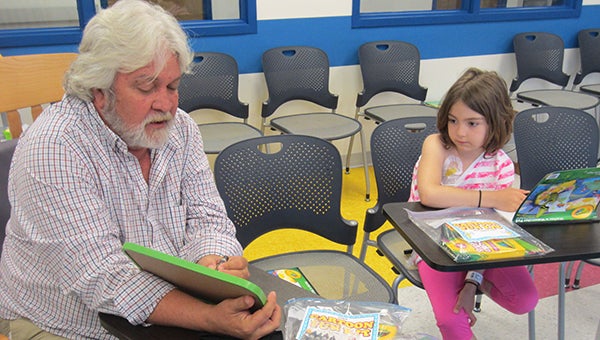Drawn to Help
Published 3:30 pm Tuesday, August 2, 2016

According to Barr, kids who draw cartoons with him are offered a chance to escape into a wonderful world in their own imaginations. Barr provides the crayons, colored pencils and sketchpads on his visits and his “no-rules approach” to drawing lets the kids decide what they want to learn how to do.
When you or someone you know is dealing with a sickness or disease, your world gets turned upside down and begins to look a little bleak. Plain white walls surround you during your hospital stay, and the rush of doctors, nurses and family members in and out of the room can create a hectic environment.
Enter Steve Barr, a cartoonist living in Columbus, and the founder and executive director of Drawn to Help. His mission is to teach children how to draw with the hope that the patient will forget about their struggles.
Barr mostly works with pediatric patients at hospitals around the area and created Drawn to Help to invite cartoonists nationwide to get on board with the initiative.
Trending
“It has the potential to really take off over the next several months,” Barr explained. “The organization is just at the ground level right now, and I’ve been trying to get cartoonists from across the country to join in as well.”
Copying Mickey Mouse directly into his desk in fourth grade is Barr’s earliest recollection of wanting to become a cartoonist.
“All the other kids started screaming about how good it was, and that drew my teacher’s attention,” Barr said. “She very politely told me to stay after school that day and scrub it until it was clean. She said, ‘Take this paper home and draw on it instead of furniture.’”
As he got older, Barr said he began to draw his own comic books and sell them to his classmates when he needed their lunch money.
“They all became really skinny because I always got their lunch money,” Barr jokingly said. “Which is why I resemble Santa Claus today.”
From there, he immediately bought more paper, pens, stamps and envelopes to draw his cartoons to mail out and sell. Today, he is the author of 13 how-to-draw books for children and was once approached by Disney to do work for them.
Trending
“They did approach me at one point, but it didn’t work out,” Barr said. “They usually don’t work with a cartoonist who already has a style and try to conform them to the Disney style of animation. I have a no-rules approach to cartooning.”
Barr also travels to local pediatric hospitals and camps to teach children with illnesses how to draw through sessions and bedside visits.
This “no-rules approach” allows the patients and camp attendees to branch out and explore a multitude of drawing styles and ideas, in Barr’s words.
“They can change and switch around anything they want to at any time,” Barr said. “It’s one of the only art forms I know of that allows a whole array of different techniques and ideas. There’s no rules on them at all, and even with the bedside visits, they get to tell me what they want to do.”
Using sketchpads, crayons and markers he provides to the children, Barr said these sessions allow children to forget about their illnesses while he is there.
Chief Development Officer Mark Schumacher of Camp Victory Junction in Randleman, N.C. recalled meeting Barr for the first time and having him do camp sessions for the kids there. The camp allows children ages 6 to 16 who have limitations and disabilities to stay and participate in camp-style programming at no cost to them.
“He has been a really key component of our family camp weekends during the spring and the fall,” Schumacher said. “It gives them a chance to really be away together with no pressure and, with Steve, he’s been able to take that ‘family unit’ and make them whole through his drawing sessions. It’s easy to rally around what he does.”
Barr is in the process of creating a digital library that allows artists from across the country to add their works. This allows Barr to expand his reach and display more works for the children he encounters.
Delfin Barral is a cartoonist living in New York who met Barr through Facebook and decided to join Drawn to Help after hearing about the initiative. Barral has been helping Barr expand the digital library and spread the word about the organization.
“He showed me what he was doing with Drawn to Help and he asked me to donate a lot of drawings to his digital library for the kids and I, of course, said yes,” Barral said. “He has a big heart and, through our phone conversations and emails, I feel like I had known him for years after we found out we had similar interests.”
This “massive” collection of coloring pages and drawing instructions will be provided to pediatric patients and their caregivers free of charge, according to Barr, and are provided by artists from all over the world, even as far away as Hong Kong.
“It provides hours of entertainment to keep the children laughing and smiling,” Barr said.
Reading studies of how art can impact hospital patients in positive ways influenced his decision to form Drawn to Help into an organization two years ago.
“I really started this in the beginning as something I was just going to do every now and then and it just kind of exploded on me,” Barr said.
Barr recalls meeting a teenage girl at one of the camps he frequents and noted the creativity and imagination of this artist he taught.
“I kept getting distracted by how wonderful her creations were at that session, but I noticed she also moved slower than everyone else,” Barr said. “Afterwards, she came up to me and said, ‘I just want to thank you, and I lost the use of my right arm to cancer and they’ve been trying to teach me how to use my left hand but I just haven’t been able to get it.’ She was drawing with her left hand that day.”
He explained that the girl realized the shapes and forms used to draw his cartoons could also be used to form letters. These miracles, as Barr said, make Drawn to Help special.
“It’s really hard to grasp how that is until you see it in front of your eyes,” Barr explained. “I’ve watched miraculous things happen and it’s more than just kids drawing funny pictures.”
Steven Harpster is another cartoonist who, like Barr, creates how-to-draw books and makes visits to elementary schools across the country to teach students to draw. Harpster, who lives in Cincinnati, said he feels Barr is genuine and that his organization is truly and wholly focused on the kids.
“It’s interesting to me that you would think that we would be in competition with each other since we’re both cartoonists and we both do how-to-draw books,” Harpster said. “But, no, I think this organization has really made an impact on the children and brings Steve and I together for a common goal. When a child visits a hospital for weeks at a time and has needles and doctors poking them constantly, art can offer them an escape from all of that.”
Donations can be made to the Drawn to Help organization to help offset the costs of drawing supplies for Barr’s visits to camps and pediatric hospitals and provide tools to the volunteers of the organization like suitcases and dry erase boards.
Drawn To Help is a sponsored project of Fractured Atlas, a non-profit arts service organization, online at fracturedatlas.org. Fractured Atlas will receive grants for the charitable purposes of Drawn To Help, provide oversight to ensure that grant funds are used in accordance with grant agreements, and provide reports as required by the grantor.
“You can touch their hearts and be a part of everything we do,” Barr said. “It’s the most fulfilling thing I’ve done in my life and I truly don’t see doing anything else at this point.”
~ Photos submitted by Steve Barr





